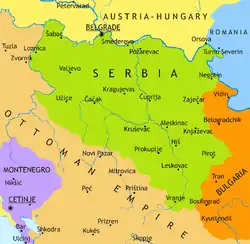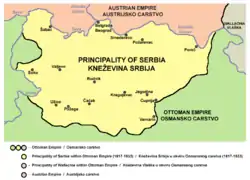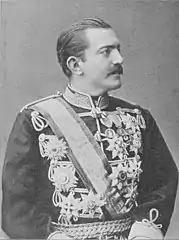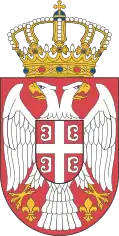Principality of Serbia Княжество Сербіа Књажество Србија | |||||||||||
|---|---|---|---|---|---|---|---|---|---|---|---|
| 1815–1882 | |||||||||||
| Anthem: Востани Сербије Vostani Serbije "Arise, Serbia" | |||||||||||
 The Principality of Serbia in 1878 | |||||||||||
| Capital |
| ||||||||||
| Common languages | Serbian | ||||||||||
| Religion | Serbian Orthodoxy (official) | ||||||||||
| Demonym(s) | Serbian, Serb | ||||||||||
| Government | Absolute monarchy (1815–1838) Unitary parliamentary constitutional monarchy (1838–1882) | ||||||||||
| Prince (Knez) | |||||||||||
• 1817–1839 (first) | Miloš Obrenović I | ||||||||||
• 1868–1882 (last) | Milan Obrenović IV | ||||||||||
| Prime Minister | |||||||||||
• 1815–1816 (first) | Petar Nikolajević | ||||||||||
• 1880–1882 (last) | Milan Piroćanac | ||||||||||
| Legislature | None (rule by decree) (1815–1838) National Assembly (1838–1882) | ||||||||||
| History | |||||||||||
• Recognition by the Sublime Porte | 1815 | ||||||||||
| 15 February 1835 | |||||||||||
• de facto independence | 1867 | ||||||||||
• de jure internationally recognized | 13 July 1878 | ||||||||||
| 1882 | |||||||||||
| Area | |||||||||||
| 1815[1] | 24,440 km2 (9,440 sq mi) | ||||||||||
| 1834[1] | 37,511 km2 (14,483 sq mi) | ||||||||||
| Population | |||||||||||
• 1815[1] | 322,500–342,000 | ||||||||||
• 1834[1] | 702,000 | ||||||||||
• 1874[1] | 1,353,000 | ||||||||||
| ISO 3166 code | RS | ||||||||||
| |||||||||||
| Today part of | Serbia | ||||||||||
The Principality of Serbia (Serbian: Књажество Србија, romanized: Knjažestvo Srbija) was an autonomous state in the Balkans that came into existence as a result of the Serbian Revolution, which lasted between 1804 and 1817.[2] Its creation was negotiated first through an unwritten agreement between Miloš Obrenović, leader of the Second Serbian Uprising, and Ottoman official Marashli Pasha. It was followed by the series of legal documents published by the Sublime Porte in 1828, 1829 and finally, 1830—the Hatt-i Sharif. Its de facto independence ensued in 1867, following the evacuation of the remaining Ottoman troops from the Belgrade Fortress and the country; its independence was recognized internationally in 1878 by the Treaty of Berlin. In 1882 the country was elevated to the status of kingdom.
Background and establishment
The Serbian revolutionary leaders—first Karađorđe and then Miloš Obrenović—succeeded in their goal of liberating Serbia from centuries-long Turkish rule. Turkish authorities acknowledged the state by the 1830 Hatt-i Sharif, and Miloš Obrenović became a hereditary prince (knjaz) of the Serbian Principality. Serbia was de jure an autonomous province of the Ottoman Empire, its autonomy was constrained by the presence of the Turkish army on its soil and by being forced to pay to Istanbul a yearly tribute of 2.3 million groschen, which represented about 10% of the country's budget.[3]
At first, the principality included only the territory of the former Pashaluk of Belgrade, but in 1831–33 it expanded to the east, south, and west. In 1866 Serbia began the campaign of forging The First Balkan Alliance by signing the series of agreements with other Balkan entities in the period 1866–68. On 18 April 1867 the Ottoman government ordered the Ottoman garrison, which since 1826 had been the last representation of Ottoman suzerainty in Serbia, withdrawn from the Belgrade fortress. The only stipulation was that the Ottoman flag continue to fly over the fortress alongside the Serbian one. Serbia's de facto independence dates from this event.[4] A new constitution in 1869 defined Serbia as an independent state. Serbia was further expanded to the southeast in 1878, when its independence from the Ottoman Empire won full international recognition at the Treaty of Berlin. The Principality would last until 1882 when it was raised to the level of the Kingdom of Serbia.
Political history
Constitutions
- 1835 Sretenje Constitution, in effect 1835
- 1838 Constitution of Serbia, in effect 1838–69
- 1869 Constitution of Serbia, in effect 1869–88
Autonomy
- Akkerman Convention (7 October 1826), treaty between the Russian Empire and Ottoman Empire, contained article 5 on Serbia: autonomy, and return of lands removed in 1813, Serbs were also granted freedom of movement through the Ottoman Empire. Rejected by Mahmud II in 1828.
- 1829 hatt-i sharif
- 1830 hatt-i sharif
- 1833 hatt-i sharif
Administrative divisions
The principality was divided into seventeen districts known as Okrug which were then divided into a number of cantons, known as Sres, according to the size of the district. The Principality had a total of sixty-six Sres.[5]
Military
The Armed Forces of the Principality of Serbia was the armed forces of the Principality of Serbia. Founded in 1830, it became a standing army to take part to the First and Second Serbo Turkish Wars of 1876-1878, the first conflict in the nation modern history, after which the country gained its full independence. It was succeeded by the Royal Serbian Army.
Demographics
In the first decades of the principality, the population was about 85% Serb and 15% non-Serb. Of those, most were Vlachs, and there were some Muslim Albanians, which were the overwhelming majority of the Muslims that lived in Smederevo, Kladovo and Ćuprija. The new state aimed to homogenize of its population. As a result, from 1830 to the wars of the 1870s in which Albanians were expelled from the country, it has been estimated that up to 150,000 Albanians that lived in the territories of the Principality of Serbia had been expelled.[6] During the Serbian–Ottoman Wars of 1876–1878, the Muslim population was expelled from the Sanjak of Niš.
| Year | Pop. | ±% |
|---|---|---|
| 1834 | 678,192 | — |
| 1841 | 828,895 | +22.2% |
| 1843 | 859,545 | +3.7% |
| 1846 | 915,080 | +6.5% |
| 1850 | 956,893 | +4.6% |
| 1854 | 998,919 | +4.4% |
| 1859 | 1,078,281 | +7.9% |
| 1863 | 1,108,668 | +2.8% |
| 1866 | 1,216,219 | +9.7% |
| 1878 | 1,669,337 | +37.3% |
| Name | 1866 Census | % population |
|---|---|---|
| Ethnicities | ||
| Serbs | 1,057,540 | 87% |
| Vlachs (Romanians) | 127,326 | 10.5% |
| Roma (Gypsies) | 25,171 | 2.1% |
| Others | 5,539 | 0.5% |
| Religion | ||
| Orthodox | 1,205,898 | 99.20% |
| Islam | 6,498 | 0.54% |
| Catholic | 4,161 | 0.31% |
| Others | 0.2% |
 The Principality of Serbia in 1817
The Principality of Serbia in 1817 The Principality of Serbia in 1833
The Principality of Serbia in 1833 The Principality of Serbia from 1833–1878
The Principality of Serbia from 1833–1878
Rulers
The Principality was ruled by the Obrenović dynasty, except for a period under Prince Aleksandar of the Karađorđević dynasty. Princes Miloš and Mihailo Obrenović each reigned twice.
| Portrait | Name | Birth | Death | From | Until | Notes |
|---|---|---|---|---|---|---|
 |
Miloš Obrenović I | March 17, 1780 | September 26, 1860 | November 6, 1817 | June 25, 1839 | |
 |
Milan Obrenović II | October 21, 1819 | July 8, 1839 | June 25, 1839 | July 8, 1839 | son of Miloš Obrenović I |
 |
Mihailo Obrenović III | September 16, 1823 | June 10, 1868 | July 8, 1839 | September 14, 1842 | son of Miloš Obrenović I |
 |
Aleksandar Karađorđević | October 11. 1806 | May 3. 1885 | September 14, 1842 | December 23, 1858 | |
 |
Miloš Obrenović I | March 17, 1780 | September 1860 | December 23, 1858 | September 26, 1860 | |
 |
Mihailo Obrenović III | September 16, 1823 | June 10, 1868 | September 26, 1860 | June 10, 1868 | |
 |
Milan Obrenović IV | August 22, 1854 | February 11, 1901 | June 10, 1868 | March 6, 1882 | |
See also
References
- 1 2 3 4 5 Michael R. Palairet (2002). The Balkan Economies C.1800-1914: Evolution Without Development. Cambridge University Press. pp. 16–17. ISBN 978-0-521-52256-4.
- ↑ Roth, Clémentine (2018). Why Narratives of History Matter: Serbian and Croatian Political Discourses on European Integration. Nomos Verlag. p. 263. ISBN 978-3845291000. Retrieved 27 March 2020.
- ↑ The Institute of History et al. 2020, p. 137.
- ↑ Stanford J. Shaw and Ezel Kural Shaw, History of the Ottoman Empire and Modern Turkey, Volume 2: Reform, Revolution and Republic—The Rise of Modern Turkey, 1808–1975 (Cambridge University Press, 1977), p. 148.
- ↑ Mijatović 1872, p. 265.
- ↑ Rama, Shinasi (2019). Nation Failure, Ethnic Elites, and Balance of Power: The International Administration of Kosova. Springer. p. 72. ISBN 978-3030051921. Retrieved 27 March 2020.
Sources
- Mijatović, E.L. (1872). The History of Modern Serbia. W. Tweedie.
- The Institute of History, B.S.U.R.R.C.; Aleksandar Rastović, A.C.; Vučetić, B.; Tatjana Ćosović, Z.M.V. (2020). War, Peace and Nation building (1853 to 1918). Institute of History. ISBN 978-86-7743-140-2.
Further reading
- Ćirković, Sima (2004). The Serbs. Malden: Blackwell Publishing. ISBN 9781405142915.
- Divac, Zorica. "Family and marital affairs in 19th century Serbia." Glasnik Etnografskog instituta SANU 54 (2006): 219–232.
- Frucht, Richard, ed. Encyclopedia of Eastern Europe: From the Congress of Vienna to the Fall of Communism (2000) online
- Jelavich, Barbara (1983). History of the Balkans: Eighteenth and Nineteenth Centuries. Vol. 1. Cambridge University Press. ISBN 9780521252492.
- MacKenzie, David (1996). "The Serbian Warrior Myth and Serbia's Liberation, 1804-1815". Serbian Studies: Journal of the North American Society for Serbian Studies. 10 (2): 133–148.
- MacKenzie, David (2004). "Jovan Ristić at the Berlin Congress 1878". Serbian Studies: Journal of the North American Society for Serbian Studies. 18 (2): 321–339.
- Meriage, Lawrence P. (1978). "The First Serbian Uprising (1804-1813) and the Nineteenth-Century Origins of the Eastern Question" (PDF). Slavic Review. 37 (3): 421–439. doi:10.2307/2497684. JSTOR 2497684. S2CID 222355180.
- Pavlowitch, Stevan K. (2002). Serbia: The History behind the Name. London: Hurst & Company. ISBN 9781850654773.
- Radosavljević, Nedeljko V. (2010). "The Serbian Revolution and the Creation of the Modern State: The Beginning of Geopolitical Changes in the Balkan Peninsula in the 19th Century". Empires and Peninsulas: Southeastern Europe between Karlowitz and the Peace of Adrianople, 1699–1829. Berlin: LIT Verlag. pp. 171–178. ISBN 9783643106117.
- Rajić, Suzana (2010). "Serbia - the Revival of the Nation-state, 1804-1829: From Turkish Provinces to Autonomous Principality". Empires and Peninsulas: Southeastern Europe between Karlowitz and the Peace of Adrianople, 1699–1829. Berlin: LIT Verlag. pp. 143–148. ISBN 9783643106117.
- Radovan Samardžić (1982). Greek-Serbian Cooperation, 1830-1908: Collection of Reports from the Second Greek-Serbian Symposium, 1980. Serbian Academy of Science and Arts, Institute for Balkan Studies.
- Stavrianos, Leften (2000) [1958]. The Balkans Since 1453. London: Hurst. ISBN 9781850655510.
- Temperley, Harold W. V. (1919). History of Serbia (PDF). London: Bell and Sons.
- Zens, Robert W. (2012). "In the Name of the Sultan: Haci Mustafa Pasha of Belgrade and Ottoman Provincial Rule in the Late 18th Century". International Journal of Middle East Studies. 44 (1): 129–146. doi:10.1017/S0020743811001280. JSTOR 41474984. S2CID 162893473.
Other languages
- Bataković, Dušan T., ed. (2005). Histoire du peuple serbe [History of the Serbian People] (in French). Lausanne: L’Age d’Homme. ISBN 9782825119587.
- Milićević, Milan (1876). Кнежевина Србија: географија, орографија, хидрографија, топографија, аркеологија, историја, етнографија, статистика, просвета, култура, управа.
- Jovan Ristić (1898). Diplomatska istorija Srbije za vreme srpskih ratova za oslobođenje i nezavisnost: Drugi rat 1875-1878. Slovo ljubve.
- Катић, Бојана Миљковић. Пољопривреда Кнежевине Србије:(1834-1867): Agriculture of the Principality of Sebia (1834-1867). Vol. 65. Istorijski institut, 2014.
- Mrđenović, Dušan, ed. (1988). "Устави и владе Кнежевине Србије". Устави и владе Кнежевине Србије, Краљевине Србије, Краљевине СХС и Краљевине Југославије (1835-1941). Belgrade: Nova knj.
- Јагодић, Милош. Насељавање Кнежевине Србије: 1861-1880: Settlement of the Princedom of Serbia: 1861–1880. Vol. 47. Istorijski institut, 2004.
- Katić, Bojana Miljković. "Сеоско професионално занатство Кнежевине Србије (1834-1866)." Историјски часопис 62 (2013): 309–329.
- Stranjaković, Dragoslav. Politička propaganda Srbije u jugoslovenskim pokrajinama: 1844-1858 godine. Štamparija Drag. Gregorića, 1936.
- Stranjaković, Dragoslav. Jugoslovenski nacionalni i državni program Kneževine Srbije iz 1844 god. Srpska manastirska štamparija, 1931.
- Stranjaković, Dragoslav., 1932. Srbija pijemont južnih slovena, 1842–1853. Nar. štamparija.
- Petrović, V., and N. Petrović. "Građa za istoriju Kneževine Srbije, vreme prve vlade kneza Miloša Obrenovića." Beograd, knjiga prva 1821 (1815).
- Nikolić, Dragan K. Izvori i priroda krivičnog prava Kneževine Srbije u vreme pripreme krivičnog zakona. 1988.
- Arsić, M. "Crkvene matične knjige u propisima Kneževine Srbije." Arhivski pregled 1.4 (2000): 52–5.
- Leovac, Danko Lj. Србија и Русија за време друге владавине кнеза Михаила:(1860-1868). Diss. Универзитет у Београду, Филозофски факултет, 2014.
- Slavenko Terzić; Slavko Gavrilović (1992). Srbija i Grčka: (1856-1903) : borba za Balkan. Istorijski institut. ISBN 9788677430030.
- Недељко, В. "AUTONOMY OF THE ORTHODOX CHURCH IN THE PRINCIPALITY OF SERBIA AND THE ARONDATION OF THE EPISCOPACIES (1831-1836)." Istraživanja: Journal of Historical Researches 25 (2016): 233–248.
- Popović, Radomir J. "Пројект Устава Србије Матије Бана из 1846. године." Мешовита грађа 34 (2013): 149–171.
- Ђорђевић, Тихомир. "Насељавање Србије, за време прве владе кнеза Милоша Обреновића (1815-1839)." Гласник Српског географског друштва 5 (1921): 116–139.
- Маринковић, Мирјана, and Терзић Славенко. Турска Канцеларија Кнеза Милоша Обреновића, 1815–1839. Историјски институт САНУ, 1999.
- Кандић, Љубица. "Делатност скупштина за време прве владе Милоша Обреновића." Анали Правног факултета у Београду 1 (1961).
- Radoš Ljušić (1986). Кнежевина Србија (1830-1839). Srpska akademija nauka i umetnosti. ISBN 9788670250253.
.svg.png.webp)

